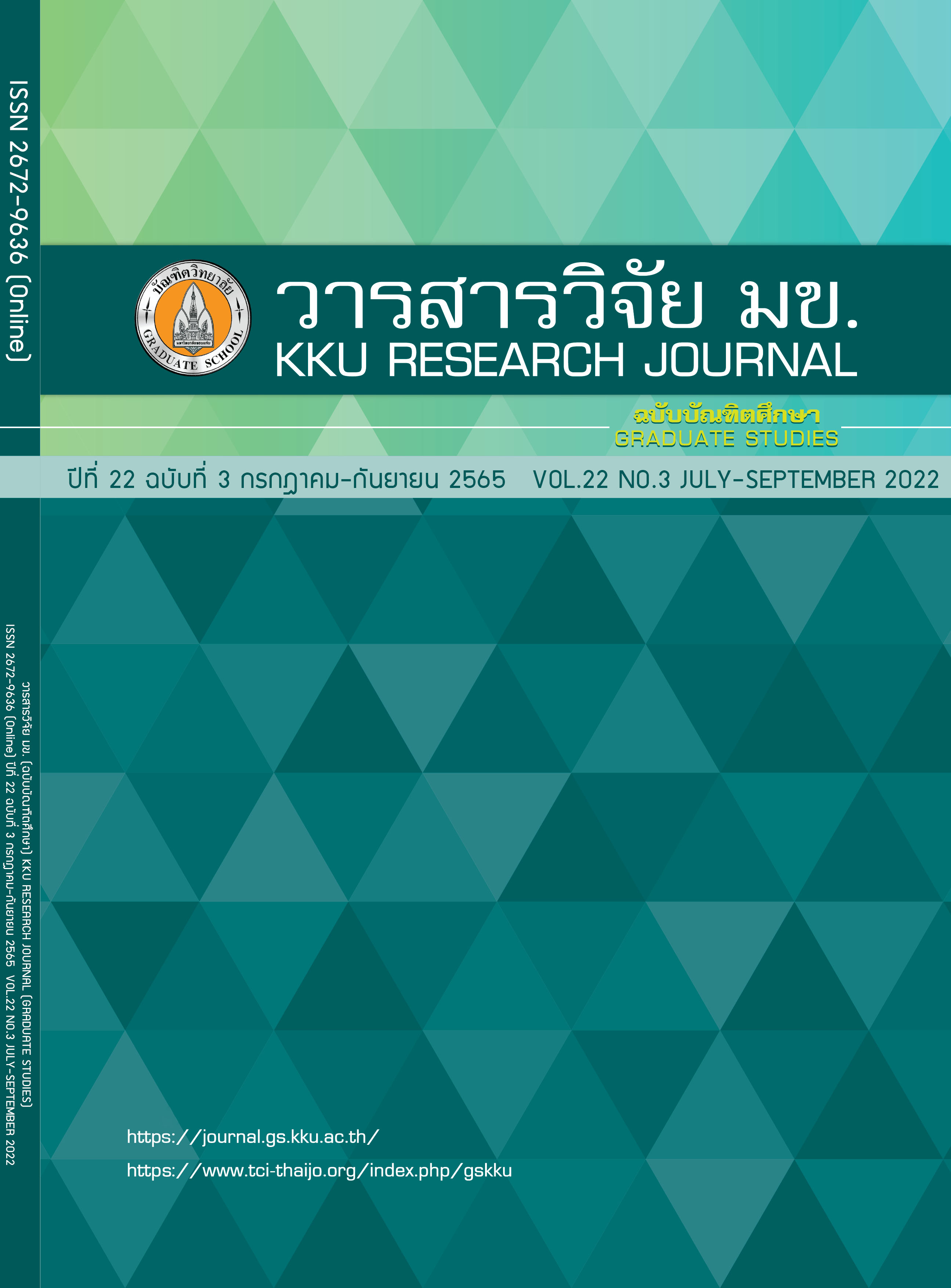Factors Related Asthma Exacerbations of Asthmatic Patients in Surat Thani Province
Keywords:
Factors related asthma exacerbations, Asthma exacerbations, Asthmatic patientsAbstract
This cross-sectional descriptive research aimed to identify factors related to asthma exacerbations among asthmatic patients. The 400 asthmas in Surat Thani province were selected by purposive sampling. Inclusion criteria were (1) an asthmatic patient diagnosed by a physician with asthma for at least 1 year, and (2) aged 18 years and over. Exclusion criteria included (1) having comorbidity affecting the respiratory system, (2) psychiatric disorder, and (3) pregnancy or undergoing surgery. The tool was an interview form which had content validity of 0.80–1 and reliability of 0.79. Data collection was carried out between May and August 2020. Chi-square test was used to analyze the relationship between variables. The results show that the proportion of asthmatic patients was equal in males and females (49.20%, 50.80%), 28.75% were aged between 21-30 years, 50.00% were married, 35.75% were relatives of family role, 28.25% had secondary education level and 28.00% had no education, 41.00% were occupation related to animals/health workers/plastic factory workers/working on bread flour, 29.00% had income between 8,001–12,000 baht. 39.75% of asthmatic patients had severe asthma exacerbation levels. The relationship analysis revealed that family roles, educational levels, history of asthma exacerbations risk, and at-risk health conditions were statistically associated with the level of asthma exacerbations (p-value<0.001). In conclusion the asthmatic patients had severe asthma exacerbation levels. Key factors that affect asthma exacerbations were family role, education level, history of asthma exacerbations risk and at-risk health conditions. Therefore, asthmatic patients should be encouraged to have sufficient knowledge for controlling asthma.
References
World Health Organization, Asthma [Online]. 2021 [cited 2021 Jan 10]. Available from: https://www.who.int/news-room/fact-sheets/detail/asthma
GBD 2019 Diseases and Injuries Collaborators, Global burden of 369 diseases and injuries in 204 countries and territories, 1990-2019: a systematic analysis for the Global Burden of Disease Study 2019. Lancet 2020; 396(10258): 1204-1222.
World Health Organization, Asthma [Online]. 2013 [cited 2021 Jan 18]. Available from: http://www.who.int/mediacentre/factsheets/fs307/en/
Global Initiative for Asthma (GINA), Pocket guide for asthma management and prevention [Online]. 2021 [cited 2021 Jan 30]. Available from: https://ginasthma.org/
Menzies-Gow A, Busse WW, Castro M, & Jackson DJ. Prevention and Treatment of Asthma Exacerbations in Adults. The Journal of Allergy and Clinical Immunology: In Practice 2021; 9(7): 2578-2586.
Guilbert A, Cox B, Bruffaerts N, Hoebeke L, Packeu A, Hendrickx M, et al. Relationships between aeroallergen levels and hospital admissions for asthma in the Brussels-Capital Region: a daily time series analysis. Environmental Health 2018; 17(35): 1-12.
International Union Against Tuberculosis and Lung Disease, The Global Asthma Report 2011 [Online]. 2011 [cited 2021 Jan 10]. Available from: http://globalasthmanetwork.org/advocacy/global.php
Patel O, Syamlal G, Wood J, Dodd KE, Mazure JM. Asthma Mortality Among Persons Aged 15–64 Years, by Industry and Occupation — United States, 1999–2016. US Department of Health and Human Services/Centers for Disease Control and Prevention 2018; 67(2): 60-65.
Hu H, Xue M, Wei N, Zheng P, Wu G, An N, et al. Sensitisation of severe asthma in different occupations: A multicentre study in China. The Clinical Respiratory Journal 2020; 15(2): 117-186.
Emons JAM, Gerth van Wijk R. Food Allergy and Asthma: Is There a Link?. Current Treatment Options in Allergy 2018; 5(1): 436–444.
Côté A, Turmel J, Boulet LP. Exercise and Asthma. Seminars in Respiratory and Critical Care Medicine 2018; 39(1): 19-28.
Nanda A, Wasan AN. Asthma in Adults. Medical Clinics of North America 2020; 104(1): 95–108.
Tang M, Henderson RJ, Holbrook JT, Lang JE. The effect of gastroesophageal reflux and proton pump inhibitors on respiratory tract infections in patients with asthma. The Journal OF Allergy AND Clinical Immunology 2019; 143(2): AB7.
Dara Mairiang, et al. Triggers and Risks Factor for admission in Patients with Asthma Exacerbation: A Study from an Emergency Room Registration Database in a Tertiary Hospital in Northeastern Thailand. Srinagarind Med L 2020; 35(4): 410-417.
Kang H-R, et.al. Risk factors of asthma exacerbation based on asthma severity: a nationwide population-based observational study in South Korea. BMJ Open 2008; 8: 1-10.
Surat Thani Provincial Health Office. Causes of Morbidity Report Surat Thani Province [Online]. 2017. [cited 2020 Mar 20]. Available from: https://sni.hdc.moph.go.th/hdc/reports
Bobko P. Correlation AND Regression. (2nd ed). Thousand Oaks: SAGE Publications, Inc; 2001.
Gebremariam TH, Binegdie AB, Mitiku AS, Ashagrie AW, Gebrehiwot KG, Huluka DK, et al. Level of asthma control and risk factors for poor asthma control among clinic patients seen at a Referral Hospital in Addis Ababa, Ethiopia. BMC Research Notes 2017; 10(558): 1-6.
Nguyen VN, Huynh TTH, Chavannes NH. Knowledge on self-management and levels of asthma control among adult patients in Ho Chi Minh City, Vietnam. International Journal of General Medicine 2018; 11(1): 81-89.
Sloand E, Butz A, Rhee H, Walters L, Breuninger K, Pozzo RA, et al. Influence of social support on asthma self-management in adolescents. Journal of Asthma 2019; 58(3): 386-394.
Newcomb P, Li J. Predicting admissions for adult asthma exacerbations in North Texas. Public Health Nursing 2019; 36(6): 779-786.
Suruki RY, Daugherty JB, Boudiaf N, Albers FC. The frequency of asthma exacerbations and healthcare utilization in patients with asthma from the UK and USA. BMC Pulmonary Medicine 2017; 17(74): 1-11.
Bacon S, Plourde A, Paine N, Cartier A, Lavoie K. Impact of acute active and passive stress on physiological responses in adults with asthma. European Respiratory Journal 2018; 52(suppl.62): PA654.
Denlinger LC, Heymann P, Lutter R, Gern JE. Exacerbation-Prone Asthma. The Journal of Allergy and Clinical Immunology: In Practice 2020; 8(2): 474-482.
Downloads
Published
Issue
Section
License
Copyright (c) 2022 KKU Research Journal (Graduate Studies)

This work is licensed under a Creative Commons Attribution-NonCommercial-NoDerivatives 4.0 International License.



